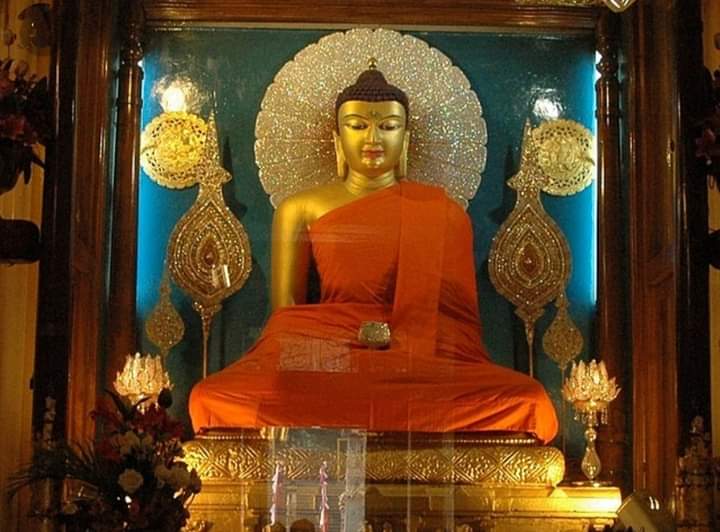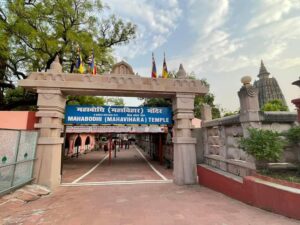Mahabodhi Temple – Bodh Gaya, Bihar:
An ancient Buddhist temple in Bodh Gaya, Bihar, India, known as the Mahabodhi Temple (literally, “Great Awakening Temple”) or the Mahbodhi Mahavihara, which is a UNESCO World Heritage Site, marks the site where the Buddha is believed to have acquired enlightenment. Bodh Gaya is located 96 kilometres from Patna and 15 km from Gaya. Over two thousand years ago, the location became a famous Buddhist pilgrimage site because it contained a living descendent of the Bodhi Tree, under which the Buddha attained enlightenment.
Mahabodhi Temple History:
According to history, Siddhartha Gautama, a young prince who observed the suffering in the world and desired to put an end to it, arrived in the forested banks of the Phalgu river, close to the Indian city of Gaya, around the year 589 BCE. He did his meditation there, beneath a peepul tree that later earned the name “Bodhi tree.” According to Buddhist texts, Siddhartha found enlightenment and the solutions he was looking for after three days and three nights. Emperor Ashoka erected the Mahabodhi Temple there somewhere around 260 BCE.
Mahabodhi Temple Timings:
The opening and closing timings of Mahabodhi Temple is 5.00 am – 9.00 pm
Opening of the Mahabodhi Mahavihara – 5.00 am
Sutta chanting and meditation – 5:30 am to 6:00 am
Offering of Kheer (rice pudding cooked with rice, milk and sugar – 10:00 am
Sutta chanting (Mahayana tradition) – 6:00 pm to 6:30 pm
Sutta chanting (Pali) – 6:30 pm to 7:00 pm
Closing of the Mahabodhi Mahavihara – 9:00 pm
Mahabodhi Temple Architecture:
One of the oldest brick buildings that have endured in eastern India is the brick Mahabodhi Temple. It is regarded as a remarkable illustration of Indian brickwork and had a significant impact on the evolution of following architectural traditions. The current temple, which dates from the Gupta period (300–600 CE), is one of the earliest and most impressive monuments built completely of brick, according to UNESCO. The 55 m (180 ft) tall central tower of the Mahabodhi Temple underwent extensive 19th-century renovations. Four more towers in the same style as the primary one encircle it.
The Mahabodhi Temple is encircled by two-meter-tall stone bars on all sides. Two unique types may be seen in the railings, both in terms of design and the materials employed. The older ones, constructed of sandstone, date to around 150 BCE, while the others, built of coarse, unpolished granite, are thought to date to the Gupta era. The earlier railings include images like Surya, the Hindu sun deity, riding a chariot carried by four horses, and Lakshmi, the Hindu/Buddhist goddess of wealth, being bathed by elephants. Figures of stupas (reliquary shrines) and garudas (eagles) can be seen on the more recent railings. Lotus flower images are also frequently seen.
Avalokitevara (Padmapani, Khasarpana), Vajrapani, Tara, Marichi, Yamantaka, Jambhala, and Vajravrh are among the images of the site.
The Mahabodhi Tree:
The historical Buddha Siddhartha Gautama, who acquired enlightenment or omniscient wisdom while meditating under the Bodhi tree at Bodhgaya, is directly associated with this tree. The Bodhi tree, which is purported to be a direct descendent of the original Bodhi Tree, is directly to the east of the temple.
Buddhist legend states that if there is no Bodhi tree present, all vegetation will be absent from the area surrounding the Bodhi tree for a distance of one royal karsa. No being can pass through the ground around the Bodhi tree, not even an elephant.
No other location can withstand the weight of the Buddha’s accomplishment, according to the Jatakas, which claim that this location is the earth’s centre.According to a different Buddhist teaching, the Bodhimanda is the last place to vanish at the conclusion of a kalpa and will be the first place to reappear when the world comes into being. A lotus is said to bloom there according to tradition, and if a Buddha is born during the new kalpa, the lotus blooms will bloom in accordance with the anticipated number of Buddhas to emerge. According to mythology, a Bodhi tree appeared in the case of Gautama Buddha on the day of his birth.
Mahabodhi Temple Buddha Statue:
Bodhgaya is home to the Great Buddha Statue, sometimes referred to as the 80-foot statue. On November 18, 1989, the Great Buddha Statue was unveiled and dedicated. The 25-meter-tall monument, the first large Buddha statue ever constructed in Indian history, was blessed during the consecration ceremony by the 14th Dalai Lama, who also attended. The statue now serves as a representation of the sacred site Bodhgaya, which is home to the Mahabodhi Temple, a World Heritage site, and attracts pilgrims from all over the world on a regular basis. It is referred to by the locals as “the 80-foot (25-meter) Buddha Statue.”
Mahabodhi Temple Address:
Mahabodhi Temple, Bodh Gaya, Bihar 824231
Mahabodhi Temple Official Website: https://bodhgayatemple.com/
How to reach Mahabodhi Temple Bihar?
By Air: The closest airports are in Patna (135 km) and Gaya (7 km). Patna is connected to numerous cities by Indian Airlines and Sahara Airlines, including Calcutta, Bombay, Delhi, Ranchi, Lucknow, and others.
By rail:(17 km) away is the closest railway station, Gaya.
By Road: Regular direct bus services run by the Bihar State Tourism Development Corporation depart from Patna and are available from Gaya (17 km), Patna (135 km), Nalanda (101 km), Rajgir (78 km), and Varanasi (252 km). route to Bodhgaya thrice a day.
Important Places in Mahabodhi Temple:
Sacred Bodhi Tree
Vajrasana
Animesha Lochana Chaitya
Cankamana
Ratnaghara
Ajapala Nigrodha Tree
Muchalinda Sarovar
Rajayatna Tree
Meditation Park
Mahabodhi Temple Photos:





